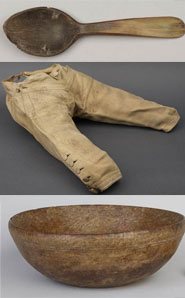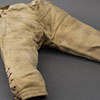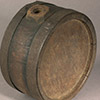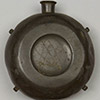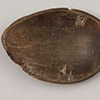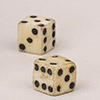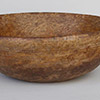|
- Verena Calas, National Park Service Museum Educator, Washington D.C
- 6-8 grades
- 5
[Back to top]
|
- This lesson unit plan draws on the extraordinary Valley Forge National Historic Park museum collections featured in the virtual museum exhibit at www.nps.gov/museum.
- Students will explore the challenges experienced by the Continental Army and its leadership, including General Washington, during their encampment at Valley Forge during the winter of 1777-1778 through object-based learning, hands-on activities, and active research. Students will work with and analyze primary source materials; including original Washington correspondence and other related documentation. Students will have the opportunity to make connections between the Revolutionary War period and the present by examining the similarities and differences between the original training manual of General Von Steuben and modern military manuals. Students will also practice analytical research, close reading, and debate skills through the examination of symbolism in colonial currency, the analysis of 18th century portraiture, and the discussion of women's role in the military.
- : During the American Revolution, General Washington and the fledgling Continental Army encountered many obstacles. However, from the Valley Forge encampment they emerge an organized and trained fighting force. Therefore, what obstacles did soldiers encounter while at Valley Forge? And, what factors contributed its emergence as a trained professional fighting force?
The following lesson plans are organized individually but make up a cohesive unit plan for "The Winter at Valley Forge". Teachers can choose to teach all five lessons as a unit, or each individually.
- This lesson introduces students to the challenges experienced by every day soldiers and their commanding officers during the winter at Valley Forge and explores how they dealt with these challenges not only physically, but mentally, as well.
- This lesson introduces students to the primary source documentation and analysis through the correspondence of men living in the Valley Forge encampment. Students will get another look into the challenges the camp presents as well as the emotional toll war can on the soldiers fighting it.
- This lesson explores the military training and tactics introduced by General Von Steuben at Valley Forge. Students will explore the importance of military manuals as modes of sharing information amongst large organized groups.
- This lesson explores the various rolls of women at the Valley Forge encampment. Students will compare the experiences of Valley Forge women to the changing rolls of American women in the military throughout history and partake in a class debate.
- This lesson explores the different kinds of currency and symbolism used not only in the Valley Forge Camp, but in the Thirteen Colonies at large. Students will also engage in the mathematical exchange of money.
[Back to top]
|
| This lesson introduces students to the challenges experienced by every day soldiers and their commanding officers during the winter at Valley Forge and explores how they dealt with these challenges not only physically, but mentally, as well. |
| MUSEUM OBJECT [photos of objects in the Parks museum collections] |
SIMILAR OBJECTS [local items similar to museum objects] & OTHER MATERIALS |
Length of time |
|
Activity 1: Washington’s Frustration
|
25 minutes |
|
- Thin pants
- Water bottle
- Plastic cup
- Plastic bowl
- Spoon
- Playing Cards
- Game Dice
- Athletic Cleats
- Rucksack Rummage Observation Sheet
|
50
minutes |
[Back to top]
|
Cite specific textual evidence to support analysis of primary and secondary sources.
Determine the central ideas or information of a primary or secondary source; provide an accurate summary of the source distinct from prior knowledge or opinions.
Integrate visual information (e.g., in charts, graphs, photographs, videos, or maps) with other information in print and digital texts.
[Back to top]
|
- Students will be able to summarize information about life in the Valley Forge camp and using primary source materials and period objects from Valley Forge National Historic Park.
- SWBAT provide visual evidence for claims made about the daily lives of soldiers at Valley Forge.
- SWBAT compare and contrast objects from the past and present as well as primary sources.
- SWBAT work collaboratively in small and large groups
- SWBAT participate in class discussions.
-
SWBAT give oral presentations.
[Back to top]
|
The Winter at Valley Forge: Background Information (PowerPoint)
[Back to top]
|
Analysis: a detailed examination of the elements of structure of something, typically as a basis for discussion or interpretation.
Engraving: the practice of carving a design onto a hard, usually flat surface (usually wood or metal) by cutting grooves into it. The piece of metal or wood is then covered in ink and stamped onto a piece of paper to produce a copy of the image.
Primary Source: an artifact, a document, diary, manuscript, autobiography, a recording, or other source of information that was created at the time under study.
Rucksack: a bag with shoulder straps that allow it to be carried on someone's back, typically made of a strong, waterproof material
Secondary Source: information that was created later by someone who did not experience first-hand or participate in the events or conditions you're researching
Summarize: to give a brief statement about the main points of something.
[Back to top]
|
|
- Use online VAFO objects, documents, maps, and photographs to further student inquiry and to address student learning objectives.
- Adapt activities for class length and grade levels (reading levels) as needed.
- Obtain for classroom use, tangible items similar to the museum objects that students can handle and study.
[Back to top] |
[Back to top]
|
|
[Back to top] |
|
Other Materials Listed in Sections C
|
[Back to top]
|
|

